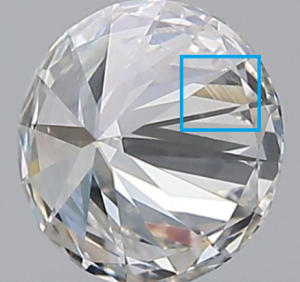Diamonds are marvels of nature, their creation a testament to the passage of time. Over millions of years, under intense heat and pressure, carbon atoms bond in a specific pattern to form the crystalline structure we know as a diamond. In this miraculous process, it is common for minute inconsistencies, referred to as inclusions, to appear within the diamond. One such inclusion, which we will focus on, is internal graining.

Internal graining is an intrinsic characteristic, frequently found in diamonds, that serves as a unique identifier, much like a fingerprint. As a crucial aspect of understanding diamond quality, it offers fascinating insights into the diamond’s formation and its journey from the depths of the earth to the jeweler’s showcase.
The Nature of Internal Graining in Diamonds
Internal graining can be described as microscopic lines, curves, or patterns present inside the diamond. These patterns, not usually visible to the naked eye, are a result of irregularities in the diamond’s crystal structure. They are formed during the gem’s creation process when the growth of the diamond is interrupted, and the crystal lattice gets deformed.
Though often invisible, internal graining can sometimes become apparent under certain lighting conditions or if the inclusion is dense or colored. When this happens, it can affect the clarity grade of the diamond and, in turn, its overall value.
The Influence of Internal Graining on Diamond Clarity
Clarity, one of the four Cs of diamond grading (Cut, Color, Clarity, and Carat), plays a significant role in determining a diamond’s value. It measures the presence of inclusions and blemishes, with fewer imperfections indicating higher clarity and, consequently, greater value.
With regards to internal graining, its influence on diamond clarity largely depends on the severity of the inclusion. Light internal graining does not usually impact the clarity grade since it’s challenging to spot, even under 10x magnification. However, if the graining is heavy or colored, it may lower the clarity grade, as these inclusions become more noticeable.
The Appearance of Internal Graining: How to Spot it
Detecting internal graining in diamonds requires a trained eye and specialized equipment. Grading labs like the Gemological Institute of America (GIA) use 10x magnification to identify and assess the nature of inclusions.
Under magnification, internal graining can appear as faint lines, curves, or reflective, wavy patterns. Depending on the orientation and density of the graining, these patterns can impact the diamond’s appearance to varying degrees. In severe cases, the graining might even create a hazy or milky appearance, significantly diminishing the diamond’s beauty and value.
The Grading of Diamonds with Internal Graining
Diamond grading is a comprehensive process that evaluates several aspects of the diamond, including its inclusions. In the case of internal graining, the GIA considers its visibility, color, and impact on transparency while grading.
Diamonds with no or minimal internal graining that doesn’t affect the stone’s transparency may still receive high clarity grades, like VVS1 (Very, Very Slightly Included 1) or VVS2 (Very, Very Slightly Included 2). If the internal graining is more noticeable, affecting the diamond’s appearance, the clarity grade could be lower, ranging from VS (Very Slightly Included) to I (Included) grades.
The Significance of Internal Graining: A Natural Imprint
Though inclusions like internal graining may affect a diamond’s value to some extent, they also serve as undeniable proof of a diamond’s natural origin. They provide a tangible link to the incredible journey that each diamond has undergone, from deep within the Earth’s mantle to the surface.
Each internal graining pattern is unique, a testament to the individual growth process of the diamond. This makes every diamond with internal graining distinct and one of a kind. For some, this uniqueness outweighs the potential decrease in clarity and can even add to the diamond’s charm and intrigue.
Internal graining, like other diamond inclusions, is an intriguing aspect of gemology. It offers insight into the geological processes that shape the creation of diamonds. Whether you view internal graining as a flaw or a unique natural imprint, understanding this phenomenon will undoubtedly enrich your appreciation for these sparkling gems.